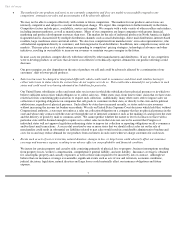CompUSA 2012 Annual Report Download - page 21
Download and view the complete annual report
Please find page 21 of the 2012 CompUSA annual report below. You can navigate through the pages in the report by either clicking on the pages listed below, or by using the keyword search tool below to find specific information within the annual report.
We exited the Software Solutions segment in June 2009. One customer remained being serviced by the Company until the second quarter of
2012 The termination of this customer has resulted in all current and prior period results have for this business segment to be classified as
discontinued operations. See Note 12 to the Consolidated Financial Statements included in Item 15 of this Form 10-K for additional financial
information about our business segments as well as information about our geographic operations.
The market for computer products and consumer electronics is subject to intense price competition and is characterized by narrow gross profit
margins. The North American industrial products market is highly fragmented and we compete against multiple distribution channels.
Distribution is working capital intensive, requiring us to incur significant costs associated with the warehousing of many products, including the
costs of maintaining inventory, leasing warehouse space, inventory management systems, and employing personnel to perform the associated
tasks. We supplement our on-hand product availability by maintaining relationships with major distributors and manufacturers, utilizing a
combination of stock and drop-shipment fulfillment.
The primary component of our operating expenses historically has been employee-related costs, which includes items such as wages,
commissions, bonuses, employee benefits and stock option expenses. We continually assess our operations to ensure that they are efficient,
aligned with market conditions and responsive to customer needs.
In the discussion of our results of operations we refer to business to business sales, consumer channel sales and period to period constant
currency comparisons. Business to business sales are sales made direct to other businesses through managed business relationships, outbound
call centers and extranets. Sales in the Industrial Products segment and Corporate and other are considered to be business to business sales.
Consumer channel sales are sales from retail stores, consumer websites, inbound call centers and television shopping channels. Constant
currency refers to the adjustment of the results of our foreign operations to exclude the effects of period to period fluctuations in currency
exchange rates.
Critical Accounting Policies and Estimates
Our significant accounting policies are described in Note 1 to the Consolidated Financial Statements included in Item 15 of this Form 10-K.
Certain accounting policies require the application of significant judgment by management in selecting the appropriate assumptions for
calculating financial estimates. By their nature, these judgments are subject to an inherent degree of uncertainty, and as a result, actual results
could differ materially from those estimates. These judgments are based on historical experience , observation of trends in the industry,
information provided by customers and information available from other outside sources, as appropriate. Management believes that full
consideration has been given to all relevant circumstances that we may be subject to, and the consolidated financial statements of the Company
accurately reflect management’s best estimate of the consolidated results of operations, financial position and cash flows of the Company for the
years presented. We identify below a number of policies that entail significant judgments or estimates, the assumptions and or judgments used to
determine those estimates and the potential effects on reported financial results if actual results differ materially from these estimates.
Table of Contents
Accounting policy Assumptions and uncertainties Quantification and analysis of effect on actual
results if estimates differ materially
Revenue Recognition.
We recognize product
sales when persuasive evidence of an order
arrangement exists, delivery has occurred,
the sales price is fixed or determinable and
collectibility is reasonably assured.
Generally, these criteria are met at the time
of receipt by customers when title and risk
of loss both are transferred, except in our
Industrial Products segment where title and
risk pass at time of shipment. Sales are
presented net of returns and allowances,
rebates and sales incentives. Reserves for
estimated returns and allowances are
provided when sales are recorded, based on
historical experience and current trends.
Our revenue recognition policy contains
assumptions and judgments made by
management related to the timing and
amounts of future sales returns. Sales returns
are estimated based upon historical
experience and current known trends.
We have not made any material changes to our
sales return reserve policy in the past three years
and we do not anticipate making any material
changes to this policy in the future. However if
our estimates are materially different than our
actual experience we could have a material gain
or loss adjustment.
Allowance for Doubtful Accounts
Receivable
. We record an allowance for
doubtful accounts to reflect our estimate of
the collectibility of our trade accounts
receivable. While bad debt allowances have
been within expectations and the provisions
established, there can be no guarantee that
we will continue to experience the same
allowance rate we have in the past.
Our allowance for doubtful accounts policy
contains assumptions and judgments made
by management related to collectibility of
aged accounts receivable and chargebacks
from credit card sales. We evaluate the
collectibility of accounts receivable based on
a combination of factors, including an
analysis of the age of customer accounts and
our historical experience with accounts
receivable write-offs. The analysis also
includes the financial condition of a specific
customer or industry, and general economic
conditions. In circumstances where we are
aware of customer credit card charge-backs
We have not made any material changes to our
allowance for doubtful accounts receivable
reserve policy in the past three years and we do
not anticipate making any material changes to
this policy in the future. However if our
estimates are materially different than our actual
experience we could have a material gain or loss
adjustment.
A change of 10% in our allowance for doubtful
accounts reserve at December 31, 2012 would
impact net income by approximately $0.6
million.
























